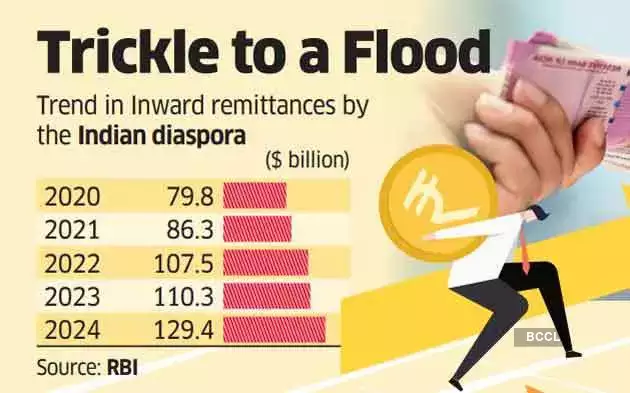Syllabus: GS3/Economy
Context
- Findings of the Reserve Bank of India’s (RBI’s) latest Remittances Survey show a significant shift in India’s remittance sources.
India’s Remittances
- India’s remittances have more than doubled from $55.6 billion in 2010-11 to $118.7 billion in 2023-24.

- U.S. and U.K. Contribution: Remittances from the U.S. and U.K. nearly doubled to 40% of total inward remittances in FY24, up from 26% in FY17.
- U.S. as Leading Contributor: The U.S. became the top source of remittances in FY21, contributing 23.4%. This increased to nearly 28% in FY24.
- UAE’s Role: UAE is still the second-largest remittance source, contributing 19.2%, with Indian migrants in blue-collar jobs like construction, healthcare, hospitality, and tourism.
- Singapore’s Rising Share: Singapore’s share reached 6.6% in FY24, up from 5.5% in FY17, marking its highest share since then.
- State-wise Distribution: Half of the remittances went to Maharashtra, Kerala, and Tamil Nadu. Other states like Haryana, Gujarat, and Punjab had smaller shares (below 5%).
- Size of Remittances: Remittances above ₹5 lakh accounted for 28.6% of total remittances, while 40.6% of the remittances were ₹16,500 or less.
Shift in Remittance Sources (2023-24):
- Advanced Economies (AEs) now account for over half of India’s remittances, overtaking Gulf Cooperation Council (GCC) countries.
- Key AE contributors: United States, United Kingdom, Singapore, Canada, Australia.
- GCC countries’ contribution has declined, partly due to economic downturns and nationalisation policies.
- Decline in GCC Remittances:
- GCC countries are historically major contributors (Saudi Arabia, UAE, Qatar, Oman, Bahrain, Kuwait).
- Impact of Covid-19, job losses, salary cuts, and “Saudisation” policies.
- UAE share fell from 26.9% (2016-17) to 19.2% (2023-24); Saudi Arabia and Kuwait’s shares also decreased.
- Growth of AE Remittances:
- The US remains the largest contributor, accounting for 27.7% in 2023-24 (up from 22.9% in 2016-17).
- Other AEs (UK, Canada, Singapore) also showed steady increases in remittance share.
- Higher wages and purchasing power in AEs lead to higher per capita remittances.
Reasons
- For Decline in GCC: The economic downturn caused by the Covid-19 pandemic resulted in widespread job losses and salary cuts, reducing the disposable income available for remittances.
- Nationalisation” policies — such as the Saudi Nationalisation Scheme or Nitaqat, also known as “Saudisation” — which prioritise local employment over foreign workers.
- Reason for Rise for AEs: They send higher per capita remittances due to higher wages (including a higher minimum wage) and the greater purchasing power of the US dollar..
- Impact of Skilled Migration: Increasing number of skilled Indian professionals in STEM, finance, and healthcare sectors in AEs.
- Role of Indian Students: The growing number of Indian students abroad contributes to remittances (loan repayments, family support).
Possible Future Trends:
- Globally, the rise of rightwing politics is leading to increasingly restrictive immigration policies in several AEs.
- This could make it more difficult for Indian migrants to secure permanent residency, and nudge them to spread out their financial risk by remitting larger sums home rather than committing to investments in their host countries.
- India is expected to be the world’s leading supplier of labor until 2048 due to its growing working-age population.
Policy Recommendations:
- To maximise remittance inflows and improve the welfare of migrant workers, India must focus on skill harmonisation at the sending-country level.
- Protect low-skilled workers from exploitation and forced deskilling.
- Engage in bilateral and multilateral agreements to regulate migration and secure better opportunities for Indian workers.
- By proactively engaging with destination countries to establish such agreements, India can secure better opportunities for its workforce, while also ensuring a steady flow of remittances.
| Remittance – Remittances are a way to electronically send funds to people, often family, in another country. 1. Usually sent by individuals working in foreign countries, especially those employed in blue-collar or skilled jobs. – Impact: Remittances are a significant source of income for many countries, contributing to their economic stability, supporting local economies, and sometimes helping to finance national trade deficits. – Modes of Transfer: Remittances can be sent through banks, money transfer operators, or digital platforms. |
Source: IE
Previous article
BIMSTEC Summit 2025
Next article
India’s Coal Boom